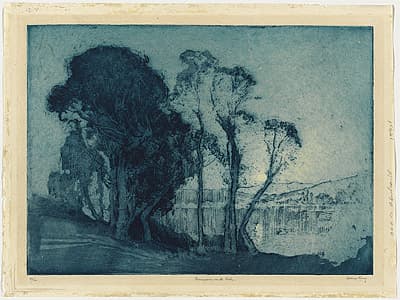
Sydney
LONG
Australia
1871
–
London
1955
England, Europe 1910-21; Australia 1921- 22; England 1922-25; Australia 1925-52; England from 1952
26.5 (h) x 36.7 (w) cm
22/60 , published state , edition of 60 , no manufacturer's mark
Signed lower right below plate-mark in black pencil, 'Sydney Long'. Not dated. Titled lower centre below plate-mark in black pencil, 'Moonrise on the Lake.' Nonscribed with edition details lower left below plate-mark in black pencil, '22/60'.
Reference: Mendelssohn (1979), 112 National Gallery of Australia, Canberra NGA 1975.97 Purchased 1975 Reproduced with the kind permission of the Ophthalmic Research Institute of Australia
In paintings and etchings of this period, the lake is a recurring theme for Long, with his favoured motifs of mirrored reflections and windswept trees appearing time and again within his decorative compositions. Dark, velvety shadows, described by watery aquatint, mark out the foreground of this twilight scene. Looking across Narrabeen Lakes from present day Wheeler Park, the view takes in the small mound of the uninhabited island that slices into the right of the composition, and the distant hills of North Narrabeen and Elanora Heights. Immediately behind the artist was a newly built bridge, which separated the mouth of the lake from Narrabeen beach. The richly hatched foliage of the trees vibrates with the suggestion of a gentle breeze coming up off the ocean at day’s end.
With the extension of the tramline to Narrabeen in 1913, the region surrounding the lake became popular with holidaymakers, and a camping ground was established on the north side of the lagoon. Long maintained a small camp along the lakeside, with a caravan and boatshed housing a wooden rowing boat. Some of his students, to whom he taught etching, would occasionally be invited to join him. Seeking respite from the bustling suburbs of Sydney’s lower North Shore, the artist basked in the serenity and natural beauty of the Northern Beaches.
A copy of the etching was possibly first exhibited in 1929 at the ‘Ninth annual exhibition of the Australian Painter–Etchers’ Society’, Sydney, 18–30 November (96, as ‘The lake’, aquatint). An artist’s proof is held by the Art Gallery of New South Wales and a copy of the print is held by the Tasmanian Museum and Art Gallery.
Emma Kindred
In paintings and etchings of this period, the lake is a recurring theme for Long, with his favoured motifs of mirrored reflections and windswept trees appearing time and again within his decorative compositions. Dark, velvety shadows, described by watery aquatint, mark out the foreground of this twilight scene. Looking across Narrabeen Lakes from present day Wheeler Park, the view takes in the small mound of the uninhabited island that slices into the right of the composition, and the distant hills of North Narrabeen and Elanora Heights. Immediately behind the artist was a newly built bridge, which separated the mouth of the lake from Narrabeen beach. The richly hatched foliage of the trees vibrates with the suggestion of a gentle breeze coming up off the ocean at day’s end.
With the extension of the tramline to Narrabeen in 1913, the region surrounding the lake became popular with holidaymakers, and a camping ground was established on the north side of the lagoon. Long maintained a small camp along the lakeside, with a caravan and boatshed housing a wooden rowing boat. Some of his students, to whom he taught etching, would occasionally be invited to join him. Seeking respite from the bustling suburbs of Sydney’s lower North Shore, the artist basked in the serenity and natural beauty of the Northern Beaches.
A copy of the etching was possibly first exhibited in 1929 at the ‘Ninth annual exhibition of the Australian Painter–Etchers’ Society’, Sydney, 18–30 November (96, as ‘The lake’, aquatint). An artist’s proof is held by the Art Gallery of New South Wales and a copy of the print is held by the Tasmanian Museum and Art Gallery.
Emma Kindred
In paintings and etchings of this period, the lake is a recurring theme for Long, with his favoured motifs of mirrored reflections and windswept trees appearing time and again within his decorative compositions. Dark, velvety shadows, described by watery aquatint, mark out the foreground of this twilight scene. Looking across Narrabeen Lakes from present day Wheeler Park, the view takes in the small mound of the uninhabited island that slices into the right of the composition, and the distant hills of North Narrabeen and Elanora Heights. Immediately behind the artist was a newly built bridge, which separated the mouth of the lake from Narrabeen beach. The richly hatched foliage of the trees vibrates with the suggestion of a gentle breeze coming up off the ocean at day’s end.
With the extension of the tramline to Narrabeen in 1913, the region surrounding the lake became popular with holidaymakers, and a camping ground was established on the north side of the lagoon. Long maintained a small camp along the lakeside, with a caravan and boatshed housing a wooden rowing boat. Some of his students, to whom he taught etching, would occasionally be invited to join him. Seeking respite from the bustling suburbs of Sydney’s lower North Shore, the artist basked in the serenity and natural beauty of the Northern Beaches.
A copy of the etching was possibly first exhibited in 1929 at the ‘Ninth annual exhibition of the Australian Painter–Etchers’ Society’, Sydney, 18–30 November (96, as ‘The lake’, aquatint). An artist’s proof is held by the Art Gallery of New South Wales and a copy of the print is held by the Tasmanian Museum and Art Gallery.
Emma Kindred
